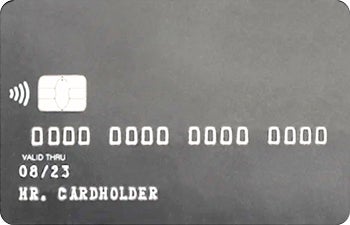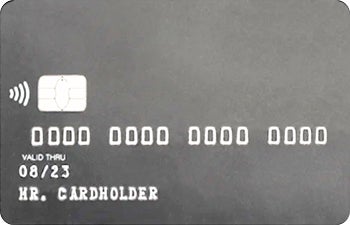Applying for your first credit card can feel like a Catch-22. You need a credit card to build credit, but it can be hard to qualify for most credit cards without already having good credit. However, a student credit card is a great way to begin your credit-building journey. Some even offer cash back on purchases or tools to help you build your credit faster.
Student credit cards are typically easier to qualify for than premium rewards or travel cards geared towards those with good credit. The trade-off with student credit cards, however, is that they typically have less robust rewards programs and fewer cardholder benefits. Once you’ve established a solid credit history, you can apply for credit cards that offer better rewards or more perks.
Here are our recommendations for the best student credit cards, plus everything you need to know about finding -- and successfully applying for -- the right card.
The Discover it® Student Cash Back* has the best value proposition of any student credit card. It offers arguably the best cash-back rewards, best welcome bonus and a top-rate introductory APR.
Though the flagship rewards category is rotating (meaning it takes a little extra work), it envelops common student expenditures like Amazon purchases, restaurants and gas stations.
Discover cards offer an Unlimited Cashback Match™ in lieu of a typical welcome bonus. At the end of your first year as a cardholder, Discover will match your cash back earned, dollar for dollar, with no limitations.
The introductory 0% APR on purchases for the first six months from account opening (18.24% to 27.24% variable APR after that) could buy you some peace of mind that emergency expenses can be carried interest-free for this period of time. Alternatively, it can also help mitigate the burden of front-loaded costs at the beginning of a semester, like dorm room furniture or books.
For more information, see our full review of the Discover it Student Cash Back.
- Intro Balance Transfer APR
- 10.99% for 6 months
- Intro Purchase APR
- 0% for 6 months
- Regular APR
- 18.24% – 27.24% Variable APR
- Balance Transfer Fee
- 3% intro balance transfer fee, up to 5% fee on future balance transfers (see terms)*
The Discover it® Student Cash Back* has the best value proposition of any student credit card. It offers arguably the best cash-back rewards, best welcome bonus and a top-rate introductory APR.
Though the flagship rewards category is rotating (meaning it takes a little extra work), it envelops common student expenditures like Amazon purchases, restaurants and gas stations.
Discover cards offer an Unlimited Cashback Match™ in lieu of a typical welcome bonus. At the end of your first year as a cardholder, Discover will match your cash back earned, dollar for dollar, with no limitations.
The introductory 0% APR on purchases for the first six months from account opening (18.24% to 27.24% variable APR after that) could buy you some peace of mind that emergency expenses can be carried interest-free for this period of time. Alternatively, it can also help mitigate the burden of front-loaded costs at the beginning of a semester, like dorm room furniture or books.
For more information, see our full review of the Discover it Student Cash Back.
- Intro Balance Transfer APR
- 10.99% for 6 months
- Intro Purchase APR
- 0% for 6 months
- Regular APR
- 18.24% – 27.24% Variable APR
- Balance Transfer Fee
- 3% intro balance transfer fee, up to 5% fee on future balance transfers (see terms)*
Bank of America® Customized Cash Rewards credit card for Students
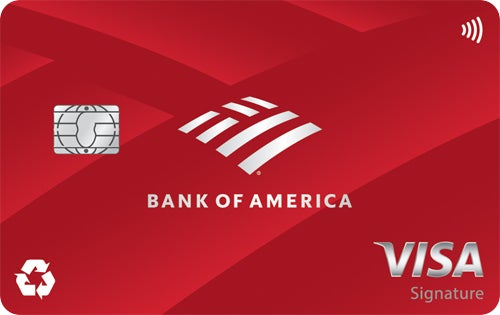
The Bank of America® Customized Cash Rewards credit card for Students* is perfect for students thanks to its low spending limit, flexible rewards program and lack of annual fee.
Its 3% choice category and 2% grocery store/wholesale club category is limited to the first $2,500 spent in combined purchases each quarter before rewards fall to 1%, but most students likely won’t be spending that much. The custom rewards you can choose from include gas, online shopping and dining -- all things students regularly spend on. It has an intro APR offer to help you avoid interest charges and a welcome bonus that shouldn’t be too hard to reach so long as you’re using the card for your necessary purchases.
Students can stay in control of their finances and make easy payments using the app, plus monitor their FICO credit score to make sure they’re building credit with responsible habits.
- Intro Balance Transfer APR
- 0% Intro APR for 15 billing cycles for any balance transfers made in the first 60 days. A 3% fee applies.
- Intro Purchase APR
- 0% Intro APR for 15 billing cycles for purchases
- Regular APR
- 19.24% – 29.24% Variable APR on purchases and balance transfers
- Balance Transfer Fee
- 3% for 60 days from account opening, then 4%
The Bank of America® Customized Cash Rewards credit card for Students* is perfect for students thanks to its low spending limit, flexible rewards program and lack of annual fee.
Its 3% choice category and 2% grocery store/wholesale club category is limited to the first $2,500 spent in combined purchases each quarter before rewards fall to 1%, but most students likely won’t be spending that much. The custom rewards you can choose from include gas, online shopping and dining -- all things students regularly spend on. It has an intro APR offer to help you avoid interest charges and a welcome bonus that shouldn’t be too hard to reach so long as you’re using the card for your necessary purchases.
Students can stay in control of their finances and make easy payments using the app, plus monitor their FICO credit score to make sure they’re building credit with responsible habits.
- Intro Balance Transfer APR
- 0% Intro APR for 15 billing cycles for any balance transfers made in the first 60 days. A 3% fee applies.
- Intro Purchase APR
- 0% Intro APR for 15 billing cycles for purchases
- Regular APR
- 19.24% – 29.24% Variable APR on purchases and balance transfers
- Balance Transfer Fee
- 3% for 60 days from account opening, then 4%
If you commute to and from school, the Discover it® Student Chrome* offers the best consistent cash-back rates available for student credit cards on gas station purchases and restaurants alike. You receive 2% cash back on gas stations and restaurants on up to $1,000 in combined purchases per quarter, and 1% after that and on all other purchases. Not to mention, Discover’s Unlimited Cashback Match™ also applies to this card, to be credited to your account after your account reaches its one-year anniversary. An introductory APR is available with this student card, too.
- Intro Balance Transfer APR
- 10.99% for 6 months
- Intro Purchase APR
- 0% for 6 months
- Regular APR
- 18.24% – 27.24% Variable APR
- Balance Transfer Fee
- 3% intro balance transfer fee, up to 5% fee on future balance transfers (see terms)*
If you commute to and from school, the Discover it® Student Chrome* offers the best consistent cash-back rates available for student credit cards on gas station purchases and restaurants alike. You receive 2% cash back on gas stations and restaurants on up to $1,000 in combined purchases per quarter, and 1% after that and on all other purchases. Not to mention, Discover’s Unlimited Cashback Match™ also applies to this card, to be credited to your account after your account reaches its one-year anniversary. An introductory APR is available with this student card, too.
- Intro Balance Transfer APR
- 10.99% for 6 months
- Intro Purchase APR
- 0% for 6 months
- Regular APR
- 18.24% – 27.24% Variable APR
- Balance Transfer Fee
- 3% intro balance transfer fee, up to 5% fee on future balance transfers (see terms)*
Capital One SavorOne Student Cash Rewards Credit Card
If you’re studying in a city where there’s lots to do, the Capital One SavorOne Student Cash Rewards Credit Card* will be a great choice for you. This card offers unlimited 3% cash back on dining, entertainment and popular streaming services and at grocery stores (excluding superstores like Walmart and Target), and at least 1% cash back on all other purchases -- this is competitive with our picks for nonstudent credit cards for restaurants and dining.
Entertainment includes ticket purchases made at movie theaters, sports promoters (professional and semiprofessional live events), theatrical promoters, amusement parks, tourist attractions, aquariums, zoos, dance halls, record stores, pool halls or bowling alleys.
- Intro Balance Transfer APR
- N/A
- Intro Purchase APR
- N/A
- Regular APR
- 19.99% – 29.99% (Variable)
- Balance Transfer Fee
- $0 at the Transfer APR, 4% of the amount of each transferred balance that posts to your account at a promotional APR that Capital One may offer to you
If you’re studying in a city where there’s lots to do, the Capital One SavorOne Student Cash Rewards Credit Card* will be a great choice for you. This card offers unlimited 3% cash back on dining, entertainment and popular streaming services and at grocery stores (excluding superstores like Walmart and Target), and at least 1% cash back on all other purchases -- this is competitive with our picks for nonstudent credit cards for restaurants and dining.
Entertainment includes ticket purchases made at movie theaters, sports promoters (professional and semiprofessional live events), theatrical promoters, amusement parks, tourist attractions, aquariums, zoos, dance halls, record stores, pool halls or bowling alleys.
- Intro Balance Transfer APR
- N/A
- Intro Purchase APR
- N/A
- Regular APR
- 19.99% – 29.99% (Variable)
- Balance Transfer Fee
- $0 at the Transfer APR, 4% of the amount of each transferred balance that posts to your account at a promotional APR that Capital One may offer to you
Bank of America® Travel Rewards credit card for Students
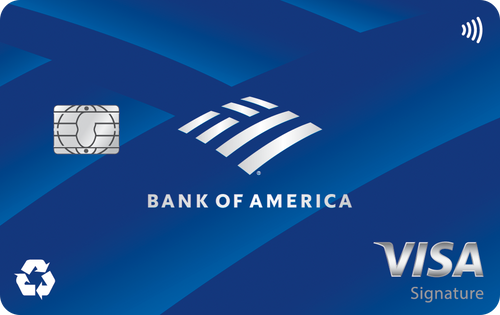
The Bank of America Travel Rewards credit card for Students* offers higher risks and rewards than most other student cards. You get a higher rewards rate -- 1.5 points per dollar on all purchases -- but must meet more requirements.
Bank of America will let you earn 25,000 online bonus points, equivalent to a $250 statement credit toward travel and dining purchases, when you sign up and spend $1,000 during the first 90 days. That’s a higher threshold than you’ll find with other student cards, but also a higher reward.
- Intro Balance Transfer APR
- 0% Intro APR for 15 billing cycles for any BTs made in the first 60 days. A fee of 3% for 60 days from account opening, then 4% will apply.
- Intro Purchase APR
- 0% Intro APR for 15 billing cycles for purchases
- Regular APR
- 19.24% – 29.24% Variable APR on purchases and balance transfers
- Balance Transfer Fee
- 3% for 60 days from account opening, then 4%
The Bank of America Travel Rewards credit card for Students* offers higher risks and rewards than most other student cards. You get a higher rewards rate -- 1.5 points per dollar on all purchases -- but must meet more requirements.
Bank of America will let you earn 25,000 online bonus points, equivalent to a $250 statement credit toward travel and dining purchases, when you sign up and spend $1,000 during the first 90 days. That’s a higher threshold than you’ll find with other student cards, but also a higher reward.
- Intro Balance Transfer APR
- 0% Intro APR for 15 billing cycles for any BTs made in the first 60 days. A fee of 3% for 60 days from account opening, then 4% will apply.
- Intro Purchase APR
- 0% Intro APR for 15 billing cycles for purchases
- Regular APR
- 19.24% – 29.24% Variable APR on purchases and balance transfers
- Balance Transfer Fee
- 3% for 60 days from account opening, then 4%
Chase Freedom® Student credit card
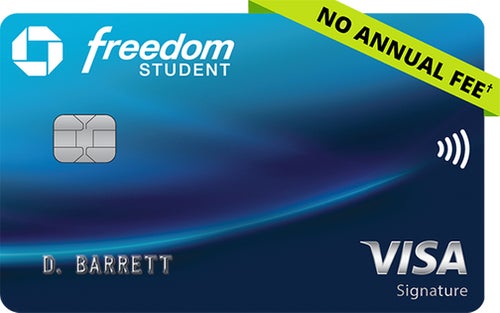
The Chase Freedom Student credit card* is a little more restrictive and less rewarding than others on this list, but it still offers a welcome bonus and a way for students to build credit through responsible use. It has no annual fee, but if you plan to travel abroad, consider another credit card as this one features foreign transaction fees.
It’s pretty simple: Use the card for all of your purchases to earn 1% cash back, with a small $20 bonus for being in good standing after each account anniversary for up to five years. There are cards here that offer more in terms of rewards, but it could be a good way to incentivize responsible behavior thanks to its $20 bonus.
You can also monitor your credit score for free to see how well you’re building credit. There’s not much to keep track of, so it’s a good first credit card.
You can learn more about the card in our Chase Freedom Student card review.
- Intro Balance Transfer APR
- N/A
- Intro Purchase APR
- N/A
- Regular APR
- 19.99% Variable
- Balance Transfer Fee
- Either $5 or 5% of the amount of each transfer, whichever is greater.
The Chase Freedom Student credit card* is a little more restrictive and less rewarding than others on this list, but it still offers a welcome bonus and a way for students to build credit through responsible use. It has no annual fee, but if you plan to travel abroad, consider another credit card as this one features foreign transaction fees.
It’s pretty simple: Use the card for all of your purchases to earn 1% cash back, with a small $20 bonus for being in good standing after each account anniversary for up to five years. There are cards here that offer more in terms of rewards, but it could be a good way to incentivize responsible behavior thanks to its $20 bonus.
You can also monitor your credit score for free to see how well you’re building credit. There’s not much to keep track of, so it’s a good first credit card.
You can learn more about the card in our Chase Freedom Student card review.
- Intro Balance Transfer APR
- N/A
- Intro Purchase APR
- N/A
- Regular APR
- 19.99% Variable
- Balance Transfer Fee
- Either $5 or 5% of the amount of each transfer, whichever is greater.
How to choose a student credit card
You should consider several factors while looking for your first credit card, including the annual percentage rate, or APR, any fees and the rewards program.
The APR is the interest rate you’ll be subject to if you don’t pay your credit card’s statement balance in full by its due date. Because college students are seen as slightly riskier borrowers due to having limited credit histories and income, most student cards have higher-than-average APRs.
That means you should always pay off your statement balance in full each month to avoid any interest charges. It’s also a good way to get into the habit of paying your bill on time to avoid any late fees, penalty APRs or damage to your credit score. Luckily, nearly all credit card issuers offer a feature to automatically pay your balance in full each month.
It’s important to look at a credit card’s terms and conditions to find the APR and fees. This document will outline what fees -- including annual fees, late fees, penalty fees, balance transfer fees or foreign transaction fees -- your card includes.
Lastly, consider whether the card you’re interested in offers rewards. Rewards can be a good way to offset spending and earn a return for necessary purchases such as gas and groceries. Not every student credit card offers rewards, and they can add another level of complexity to a card. But if you can handle the card responsibly, the benefits may outweigh the negatives.
The most rewarding student cards include the Discover it® Student Cash Back and the Capital One SavorOne Student Cash Rewards Credit Card.
How to responsibly maximize your card benefits
Some student credit cards will reward you for using the card responsibly, either by offering an annual bonus or by increasing the rate at which it earns rewards. To get these benefits, be sure you’re paying your monthly bill on time, which can also help you avoid interest charges that would otherwise cut into your profit.
Student credit cards often offer a way for you to keep track of your credit score. It’s a good way to see how paying on time and maintaining a low credit utilization ratio -- the ratio of your total debt compared to your total available credit -- can lead to healthy credit scores. It’s also a good idea to keep your credit card account open as long as possible. The age of your credit accounts affects your credit and closing an old credit account can even ding your credit score in the long run.
Why it’s important to build credit
Your credit score determines whether you qualify for a loan and what kind of terms you get, whether it be an auto loan, a mortgage on a house or even a credit card. A good credit score is how you show lenders you’re not a risk.
Having a higher credit score will lead to you getting more favorable rates and terms when it comes time to apply for credit products. The better the credit score, the lower the interest rate will be on credit products, and the less you’ll have to pay over time. You’ll also be more likely to qualify for credit products at all. If you want to lead a good financial life, it starts with building a solid credit history through on-time payments.
How to build credit with your student credit card
Getting your first credit card is a big responsibility. You’ll want to establish healthy credit habits once you open your card to build your credit and avoid credit card debt. When using your card, be sure to:
- Make your monthly payments on time and in full. You can avoid interest charges if you pay your credit card bill in full and on time every month. Late payments can tank your credit score, and you might have to pay hefty penalty fees or interest.
- Avoid applying for several credit cards within a short time period. Generally, when you apply for a new credit card, the lender initiates a hard pull on your credit. This can ding your credit score by a few points, though the impact is only temporary. Use your credit score to gauge your approval odds before applying to reduce new card denials. Space out your applications by a month or two and you should be fine.
- Maintain a low credit utilization ratio. Experts suggest keeping your credit card balance at or below 30% of your total credit limit to maintain a strong credit score.
- Track your monthly spending. Look at your monthly statement and transactions regularly to keep an eye on your budget and make sure you’re not overspending with your card. This will also help you spot any fraudulent transactions or suspicious activity, which you should immediately report to your card issuer.
Once your credit score improves and you move on to a credit card with more benefits, you should consider keeping your student credit card account open -- even if you no longer use it.
Closing that account (especially if it’s one of the oldest accounts on your credit report) can have a negative effect on your credit score. As long as it’s not costing you an annual fee, it’s a good idea to keep the account open and use it only occasionally or set up a recurring payment that you can easily pay off each month.
Another option would be to ask if the bank can roll the credit line in with another high-rewards credit card. That way, you get to keep the credit line open to help your credit score, but it’s one less card to manage.
Are you ready for a credit card?
If you’re responsible with your money, it might be time to consider a student credit card. If you consistently save and budget well, you’re likely ready to begin building credit via a credit card.
An emergency credit card can be a great way to have an additional source of funding in times of trouble -- especially if you’re going away to school for the first time.
The key to being a successful cardholder is to stay organized. Track what you’re spending, pay your bill in full each month and pay attention to the rewards program to maximize the value you get from the card.
Alternatives to a student credit card
If you’re under 18 and not old enough to have your own credit card, you can consider becoming an authorized user on a parent or other family member’s account. It’s a good way to learn the basics of a credit card without having one of your own. Becoming an authorized user can help you build a positive credit history as long as the issuer reports authorized user activity to the three major credit bureaus, Equifax, TransUnion and Experian. Keep in mind that if the primary user misuses their credit card, such as by carrying a balance or missing bill payments, your credit score could suffer from being an authorized user on that card.
If you’re looking to start building credit but feel you’re not ready for a credit card, there are some third-party companies that will report your rent payment -- for a fee -- to the three credit bureaus as a way to build your credit. Paying your student loans on time will also contribute to building credit.
If you can’t qualify for or don’t want an unsecured credit card, consider a secured credit card. In exchange for a one-time security deposit (that’s usually refundable after showing responsible use) to form your credit limit, you could start building credit.
How to apply for a student credit card
Follow these steps to apply for a student credit card:
- Choose a credit card that aligns with your needs as a student.
- Securely fill out an application by following one of the links above. You’ll need to provide personal information such as your name, age, Social Security number, address and annual income. Depending on the issuer, you may receive a decision within a few minutes or a few weeks.
- Once you’re approved for your credit card, use it to make purchases. Only charge what you can afford to pay off each month and always pay your bill on time and in full to avoid interest charges and late fees.
FAQs
No, you can apply for a student credit card if you’re unemployed. However, you will need enough income to cover any balances you accrue with your card.
Most credit cards require you to be at least 18 years old to apply. But there are debit cards designed for younger people, and some banks may allow children younger than 18 to be added as an authorized user on their parent’s credit card.
Most credit cards, student or otherwise, are accepted internationally, but some come with foreign transaction fees that are charged each time you need to make a purchase in another currency. You can technically use those cards abroad, but the fees will quickly add up. Instead, look for a student credit card with no foreign transaction fees if you plan to travel or study abroad.
Our methodology
CNET reviews credit cards by exhaustively comparing them across set criteria developed for each major category, including cash-back credit cards, welcome bonus credit cards, travel rewards credit cards and balance transfer credit cards. We take into consideration the typical spending behavior of a range of consumer profiles -- with the understanding that everyone’s financial situation is different -- and the designated function of a card.
*All information about the Discover it Student Cash Back, Discover it Student Chrome, Bank of America Travel Rewards credit card for Students, Bank of America Customized Cash Rewards credit card for Students, Chase Freedom Student credit card, Capital One SavorOne Student Cash Rewards Credit Card and Deserve EDU Mastercard for Students has been collected independently by CNET and has not been reviewed by the issuer.
This article includes some material that was previously published on NextAdvisor, a CNET Money sister site that was also owned by Red Ventures and which has merged with CNET Money. It has been edited and updated by CNET Money editors.
The editorial content on this page is based solely on objective, independent assessments by our writers and is not influenced by advertising or partnerships. It has not been provided or commissioned by any third party. However, we may receive compensation when you click on links to products or services offered by our partners.






